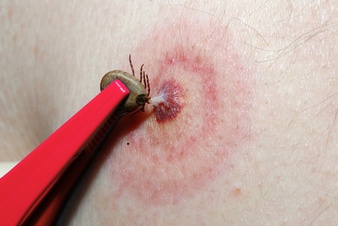|
Later Symptoms of Lyme Disease
The later symptoms of Lyme disease (listed below) soon follow the initial stage of infection which is frequently marked by the characteristic
lyme disease bulls-eye rash
(right). This rash, however, is not always present so a person bitten by a tick should be aware of and looking for further symptoms. Within days to weeks after infection, the bacteria can be found in the blood, cerebrospinal fluid, the tissue around the heart, the retina of the eye, muscle tissue, bone, the thin layer of membrane surrounding the brain, the brain cells, the spleen and the liver.
The rapid spread to multiple organs can lead to a variety of symptoms that overlap with the recognized symptoms of other chronic diseases such as ALS, Alzheimer's, arthritis, chronic fatigue syndrome, fibromyalgia, lupus, MS, Parkinson's, and many others.
Because of this, Lyme disease is known as the "master mimic" disease. This also results in a high rate of misdiagnosis. Of course, this results in non-treatment and allows progression to chronic Lyme, a much more invasive and difficult stage to eradicate.
In the chronic stage, later symptoms of Lyme disease may include:
- arthritic-like swelling and joint pain
- tingling and numbness in the hands, feet, and back
- a constant lack of energy
- trouble focusing thoughts
- memory loss
- weakness or paralysis of facial muscles
And there is much more. To help avoid these later symptoms you should know the
earlier signs and symptoms of Lyme disease
of Lyme disease so that you can get prompt treatment. Also, know the correct method for
treating tick bites
when they first occur to help minimize exposure to Lyme disease. There are
Lyme disease alternative treatments
many of which are things you should be doing anyway to boost your immune system. However This is a VERY SERIOUS DISEASE and you should seek treatment soon as it becomes much more difficult to treat if allowed to progress to the chronic stage.
Lyme is an insidious and debilitating disease. It has reached epidemic proportions across the world and has a very high rate of misdiagnosis. One pioneer in the field of Lyme disease is Dr. Murakami who heads the Dr. E. Murakami Centre for Lyme Research, Education and Assistance Society in Hope, BC. I recently heard Dr. Murakami, a pioneer in the area of Lyme disease, speak and would recommend anyone visiting his website:
www.murakamicentreforlyme.org.
It is their mission to educate and further research Lyme to effectuate positive changes within our health care system for victims of Lyme in Canada.
|
Keep up to date with
valuable insights into
pain management via
a healthy lifestyle.
Receive the monthly
Natural Pain Relief
Guide Newsletter.
News articles, health
tips, specials, freebies.
Enter your email and name
in the form to the right.
|
|
|










New! Comments
Have your say about what you just read! Leave me a comment in the box below.